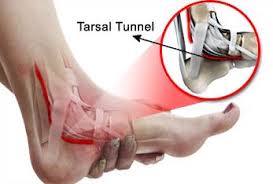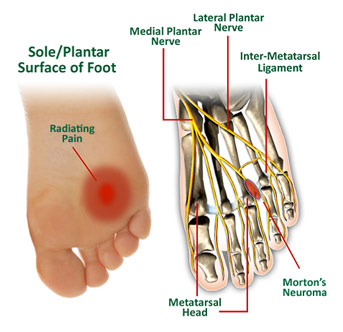A pinched nerve happens when too much pressure is put on a nerve by surrounding tissues, such as tendons, muscles, bones, or cartilage. This pressure interrupts the nerve's function, causing paresthesia (weakness, numbness, tingling sensations, and pain). Damage from a pinched nerve might be minor to severe, and it could cause temporary to long-lasting problems. However, with rest and other conventional treatments, many people recover from a pinched nerve within a couple of days or weeks.
Causes of Pinched Nerve in Foot
A tumor, vascular lesion, or nerve compression syndromes, such as tarsal tunnel syndrome, could damage surrounding nerves, and cause paresthesia along with pain. A pinched nerve can happen in various regions of the foot, and is frequently caused by trauma or a tight shoe. Unfortunately, people who have flat feet or high arches are more prone to developing a pinched nerve in their foot. A diagnosis is based on determining the underlying conditions that are causing the paresthetic sensations.
Tarsal Tunnel Syndrome
 One of the nerves which provides sensation to the bottom of the foot in the tarsal tunnel is the tibial nerve. When this it is compressed, the resulting condition is called tarsal tunnel syndrome, one of the possible reasons for your pinched nerve in foot. Tarsal tunnel syndrome produces symptoms along the nerve that runs from inside the ankle to the bottom of the foot. Symptoms may include:
One of the nerves which provides sensation to the bottom of the foot in the tarsal tunnel is the tibial nerve. When this it is compressed, the resulting condition is called tarsal tunnel syndrome, one of the possible reasons for your pinched nerve in foot. Tarsal tunnel syndrome produces symptoms along the nerve that runs from inside the ankle to the bottom of the foot. Symptoms may include:
- A sensation similar to an electrical shock, tingling, and burning
- Radial pain or shooting pain
- Numbness
For some people, the symptom may be isolated and affect just one spot. For others, it could extend to the calf, heel, arch, and even the toes. Sometimes the symptoms can appear suddenly, and they are often brought on or aggravated by overextending the foot, such as prolonged walking, standing, a new exercise program, or over exercising.
Neuroma
 A neuroma is a mass or benign tumor growing from a nerve, and a very painful condition called Morton's neuroma affects the padded part of the sole of the foot. It's located behind the third and fourth toes and before the arch. Morton's neuroma includes a thickening of the nerve tissue leading to your toes, and symptoms and causes can include:
A neuroma is a mass or benign tumor growing from a nerve, and a very painful condition called Morton's neuroma affects the padded part of the sole of the foot. It's located behind the third and fourth toes and before the arch. Morton's neuroma includes a thickening of the nerve tissue leading to your toes, and symptoms and causes can include:
- Pain that radiates from the ball of the foot to the ankle or the ball of the foot to the toes
- Numbness, cramping, or tingling sensation
- Tight shoes that usually aggravate the symptoms
- Awkward bending of the toes, or stepping the wrong way
- Feeling as if you are standing on a fold in your sock or a pebble in your shoe
- Feeling a lump in the ball of your foot or a clicking sensation when you walk
Treating Pinched Nerve in Foot
The best approach to treating pinched nerves in foot is to help reduce the compression to the affected nerve and allow the area to heal itself.
For Tarsal Tunnel Syndrome
A variation of options and treatments, sometimes used together, can be used to treat tarsal tunnel syndrome. They include:
- Rest the foot to prevent any further injury during the healing process.
- Ice: Apply an ice pack to the affected area by placing a thin towel between the ice and the skin. Apply ice for 20 minutes, and then wait at least 40 minutes before re-applying.
- Medications: Non-steroid anti-inflammatory drugs, such as ibuprofen, will help reduce the pain and inflammation.
- Injection: Injections of a local anesthetic for pain relief, and an injected corticosteroid for treating the inflammation.
- Immobilization: Wearing a cast to restrict movement of the foot. The cast is sometimes necessary to help the nerve and surrounding tissue to heal.
- Orthotic devices: To help maintain the arch, and limit the motion that can cause compression of the nerve, custom shoe inserts or supportive shoes may be prescribed by your podiatrist.
- Bracing: Fitted with a brace to reduce the amount of pressure on the foot for patients with flat foot, or those with severe symptoms and nerve damage.
For Neuromas
There are a number of things you could do at home to help treat neuroma symptoms and relieve the pinched nerve in foot. However, you should first see your podiatrist for an evaluation, because without the proper diagnosis, symptoms may often get worse. If you have a confirmed case of neuroma, you could be offered a mix of in-office and at-home therapies. As with many foot maladies, treatment for neuromas typically begins with traditional management and care, such as:
- Shoes: Wearing shoes that offer more room around the toes or with shock-absorbing properties, and switching to a lower heel or extra padding, may help relieve symptoms. It might also help if you adjust the way you lace your shoes.
- Taping and padding: Taping could be used to alter the functioning of your foot as you walk and to help relieve the pressure on the neuroma, or you might be instructed to use small cushions or pads on the ball of the foot to alleviate the pressure that causes the pain.
- Orthotics: Shoe inserts and orthotics may be used to treat a pinched nerve in foot related complaints, and may also be used to reduce the pain and other neuroma symptoms.
- Medication: Your podiatrist may recommend cortisone injections, anti-inflammatory medications, or both, depending on the severity of your symptoms. Make sure any medications are used as directed, and let your podiatrist know if you have any allergies to the medication. You'll also need to let your podiatrist know what other medications that you are taking, such as vitamins, or supplements to avoid any adverse interactions.
- Surgery: If traditional interventions fail to alleviate your neuroma symptoms, or your symptoms have worsened, surgery may become necessary. Surgery for neuromas often involves removing enlarged or inflamed nerves that are causing symptoms and is typically performed as an outpatient procedure.
